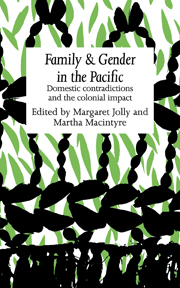Book contents
- Frontmatter
- Contents
- List of contributors
- Acknowledgements
- Map of main island groups of the Pacific
- Map of Papua New Guinea – Provinces
- Introduction
- 1 New England missionary wives, Hawaiian women and ‘The Cult of True Womanhood’
- 2 Changes in the lives of ordinary women in early post-contact Hawaii
- 3 Domestic structures and polyandry in the Marquesas Islands
- 4 The object lesson of a civilised, Christian home
- 5 Medical care and gender in Papua New Guinea
- 6 Suffer the children: Wesleyans in the D'Entrecasteaux
- 7 Women in contemporary Central Enga society, Papua New Guinea
- 8 Better homes and gardens
- 9 God, ghosts and people: Christianity and social organisation among Takuru Wiru
- 10 Sins of a mission: Christian life as Kwaio traditionalist ideology
- 11 Sacred spaces: churches, men's houses and households in South Pentecost, Vanuatu
- 12 Bond-slaves of Satan: Aboriginal women and the missionary dilemma
- Bibliography
- Index
11 - Sacred spaces: churches, men's houses and households in South Pentecost, Vanuatu
Published online by Cambridge University Press: 05 November 2011
- Frontmatter
- Contents
- List of contributors
- Acknowledgements
- Map of main island groups of the Pacific
- Map of Papua New Guinea – Provinces
- Introduction
- 1 New England missionary wives, Hawaiian women and ‘The Cult of True Womanhood’
- 2 Changes in the lives of ordinary women in early post-contact Hawaii
- 3 Domestic structures and polyandry in the Marquesas Islands
- 4 The object lesson of a civilised, Christian home
- 5 Medical care and gender in Papua New Guinea
- 6 Suffer the children: Wesleyans in the D'Entrecasteaux
- 7 Women in contemporary Central Enga society, Papua New Guinea
- 8 Better homes and gardens
- 9 God, ghosts and people: Christianity and social organisation among Takuru Wiru
- 10 Sins of a mission: Christian life as Kwaio traditionalist ideology
- 11 Sacred spaces: churches, men's houses and households in South Pentecost, Vanuatu
- 12 Bond-slaves of Satan: Aboriginal women and the missionary dilemma
- Bibliography
- Index
Summary
Family life has become purer by the abolition of polygamy, and more happy by the residence of man and wife together, which did not characterise their heathen state.
(Steel 1880:50)In both the indigenous and Christian religions of Vanuatu space is sacralised. In the indigenous system sanctity was created by the segregation of living people and the ancestors, low-ranking people and high-ranking people, and women and men. Such segregations entailed divisions between the human settlement and the surrounding environment, between sacred areas and mundane spaces, between men's houses and domestic dwellings, and within both men's house and dwelling the differentiation of cooking fires on the basis of rank and gender.
As part of the process of conversion Christian missionaries and local converts trespassed over these boundaries sacred to the ancestral religion and in varying degrees tried to deconstruct these sacred spaces and replace them with new ones. This was most obvious in the building of Christian churches, but also involved the reconstruction of dwellings and associated efforts to reshape domestic existence and reform family life.
This chapter explores this process in one particular region of Vanuatu, the communities of South Pentecost.
- Type
- Chapter
- Information
- Family and Gender in the PacificDomestic Contradictions and the Colonial Impact, pp. 213 - 235Publisher: Cambridge University PressPrint publication year: 1989
- 13
- Cited by



